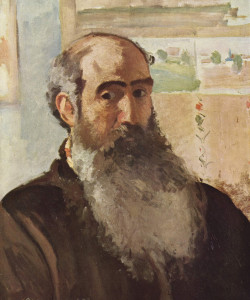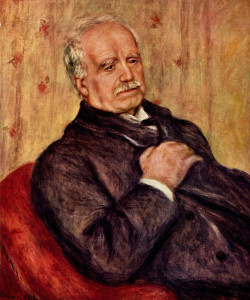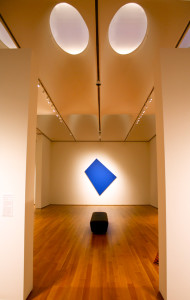
Orchard in Bloom, Louveciennes
Camille Pissarro, French, 1872
(oil on canvas)
National Gallery of Art, Washington
Let’s conclude our discussion on the nature of art.
For our final entry in our discussion, I have chosen Camille Pissarro’s Orchard in Bloom, Louveciennes, because it addresses the question of power and art and because it illustrates that by the mid-nineteenth century the course of Western art would turn into something more modern. Before we discuss these changes and look more closely at Pissarro’s work, let’s continue with our argument. Let’s review. In the first entry and the beginning of the second entry we looked at seven works of art, each one from a different culture, time and place. What did we learn? First, we learned that the history of art seems to be one in which leaders and those who have power and wealth portray themselves and their beliefs in ways that support and enhance their power and status. Second, we learned that art seems to be a means with which nations and other types of ruling bodies can shore up their power and communicate deeply held beliefs. But we quickly realized there was more to the nature of art than that kind of power. We put forward the argument that to answer the question of art and of great art in particular, one must focus instead on the artists who create art and the viewers who experience it. We looked at The Starry Night, by Vincent van Gogh and Bull’s Head by Pablo Picasso and concluded that art is art when an artist is so adept at manipulating the tools and techniques and ideas via the elements of art that he or she is able to engage viewers over and over again, over the course of many years, and move them both emotionally and intellectually.
By this point, I am sure you have several questions. First, you ask, “Is there a difference between an image or object that merely serves some purpose and art?” Yes, there is. One will eventually tire of the former, no matter how much it may stir one’s emotions or intellect at first. Indeed, one will only find continued satisfaction or interest when looking at newer and newer examples. In the same vein, if images or objects merely shock, they will be tossed aside just as readily. Images and objects that are art, however, will continue to interest one and connect one to the world, to oneself and to others in different ways. That art speaks to us in different ways is key. A work of art is open-ended and multi-dimensional and will engage viewers in new and different ways.
This brings us back to our discussion about the role of art in relation to the kind of power that individuals and institutions have sought throughout the ages. How does modern and contemporary art relate to this kind of power? Is power even a factor? And what exactly is modern art? As we learned, it seems that the driving force behind much of the history of art is power. By the mid-nineteenth century, however, two things changed the course of Western art and transformed art into something more modern: first, a critical mass of artists began to make art outside normal channels (outside the influence of powerful religious, governmental and academic institutions); and second, a critical mass of artists began to make art, not for any particular audience (whether church or government or wealthy burgher), but for themselves. These are the key factors that differentiate traditional art from modern art.
Camille Pissarro’s Orchard in Bloom, Louveciennes is an example of this change. The painting was made outside the influence of powerful religious, governmental and academic institutions and wasn’t made for any particular audience, but to satisfy the artist, Camille Pissarro, himself. At the time, Pissarro was helping to develop a radical new style of art called Impressionism with other artists, including Claude Monet, Edgar Degas and Pierre-Auguste Renoir. Although these artists were helping to develop the style of art called Impressionism, each had their own unique style.
Pissarro’s unique style had been germinating for some time. In part through the earlier influence of his tutor, artist Camille Corot, Pissarro painted from nature, out-of-doors. However, while Pissarro shared Corot’s love of rural scenes, unlike Corot who finished his paintings in the studio, Pissarro finished his paintings outdoors, often at one siting, which gave his work a stark realism that was at odds with the accepted standards of the day. Pissarro painted what he saw—oddly shaped bushes, unsightly mounds of earth and trees alike. Because such rural scenes did not improve upon nature, his work was often criticized as being vulgar. However, Pissarro continued to paint figures and landscapes in a manner without artifice or grandeur.
Eventually, through the support of the French art dealer Paul Durand-Ruel, Pissarro and his fellow artists were able to display their own unique styles to the public. In 1874, the group held the first of their “Impressionist” exhibitions. Understandably, the work shocked many viewers and critics. Missing from their scenes were the expected religious, historical or mythological settings. Moreover, the paint was applied in a sketchy and incomplete manner, and often thickly, and shadows were painted with the reflected light of nearby objects, even those that presumably lay outside the picture frame. In short, the works of Pissarro and the others seemed vulgar and commonplace. However, despite this early criticism and largely through the support of Durand-Ruel, Pissarro and the others continued to explore their own unique styles.
Orchard in Bloom, Louveciennes is one of five paintings Pissarro sent to the first Impressionist show in 1874. Painted in 1872, it is modest in scale and unassuming in subject matter. Pissarro’s strokes are broad and the color pallet is muted and understated. Line and color convey a mood of tranquility, in which several barely discernible peasants inhabit a rural landscape. Pissarro had only recently returned home to Louveciennes from London, where he and his family had found a safe haven from the Franco-Prussian War. During the war, Pissarro’s house had been occupied by Prussian troops. Returning to France in 1871, Pissarro discovered that many of his paintings that he had left behind had been destroyed. Apparently, his paintings had been used by the troops as door mats, upon which the men would wipe their muddy boots. Orchard in Bloom, Louveciennes was painted the spring after Pissarro’s return home. At the time, Pissarro’s work was beginning to attract buyers. Perhaps the delicate white blossoms and freshly plowed earth in the painting are symbols of hope and renewal. As Orchard in Bloom, Louveciennes clearly announces: a new, modern art had arrived!
Because Pissarro and his fellow Impressionists painted according to their own personal dictates—they made a clean break from a past that had its roots planted firmly in the ancient, classical world, and modernism emerged. In addition, because they made art mainly to satisfy themselves, the meaning of art stopped being about power. Instead, it became an act of creation, with the meaning resting firmly in the hands of the artist who made it and the viewers who experience it. Of course, there have always been artists who have made art, indeed great art, for themselves, even when working within normal channels and for a particular audience. This approach to art didn’t suddenly show up in the mid-nineteenth century. But it did lead to a modernist movement at this time and a movement so powerful, contemporary artists today maintain they make art first and foremost for themselves.
In conclusion, a shift in intent by a critical mass of artists in the mid-nineteenth century onward weakened the relationship between art and the kind of power that individuals and institutions have sought throughout the ages. But that images and objects have been used as a means towards power throughout history is secondary to our main question. After all, as we learned, one must focus on the artists who make art and the viewers who experience art in order to answer our question, “What is art?” But how? All one has to do is imagine. Imagine what ancient people would have experienced when approaching Torso of an Emperor, how the imposing sculpture would have stirred their emotions and perhaps given some of them a sense of awe and others, needed reassurance. Imagine what members of the Roman Catholic Church would have experienced when gazing upon Stanzione’s Assumption of the Virgin, how the painted narrative would have stirred their emotions as well and given them answers to questions both universal and personal. Imagine how the work of Pissarro and the other Impressionists deeply affected the minds and emotions of the public and critics. Now imagine how these works continue to stir the emotions and minds of contemporary people today. Indeed, one must look elsewhere to answer the question, “What is art?” But where? Simply look for the images and objects through which viewers connect to the world, to themselves and to others, and in some way continue to do so, over and over again. Whether imposing ancient Roman sculpture, inspiring Italian altarpiece or descriptive French landscape, I guarantee you, no matter what period of history one looks at, this is where you will find artists striving for something greater and viewers being transformed in ways most subtle and profound! This is where you will find the true power of art!
Let’s look once more at Blue Panel. What if I were to tell you the artist who made Blue Panel finds his inspiration in the spaces between things, spaces set free in an open window or door for example? Would this change how you view this work? For many people, Ellsworth Kelly seems to have taken a flat canvas and turned it into a moving, three-dimensional, sculptural form. What do you think? Does Blue Panel appear to vibrate with color and light and life? If you stare at it long enough, perhaps it will heighten your sense of the world. It may even transport you to a familiar place that you have long forgotten. It’s worth a try.
§
Would you like to see Orchard in Bloom, Louveciennes? All you have to do is pay a visit to the National Gallery of Art in Washington, DC. I’m sure someone there will be happy to point you in the right direction. Would you like to see Blue Panel in person? All you have to do is visit the North Carolina Museum of Art in Raleigh, North Carolina. Blue Panel is in the Modern galleries. If you are interested in having a tour at either the National Gallery of Art or the North Carolina Museum of Art, check on-line or call ahead to find out the days and times tours are given to the public. Or perhaps you can contact either of these museums ahead of time and arrange for you and your friends to have a private tour. I’m sure a docent at either the National Gallery of Art in Washington or the North Carolina Museum of Art in Raleigh would be happy to show you and your friends the many wonderful works of art. Whether you visit these museums on your own or have a tour with a docent, it will be well worth your time!



